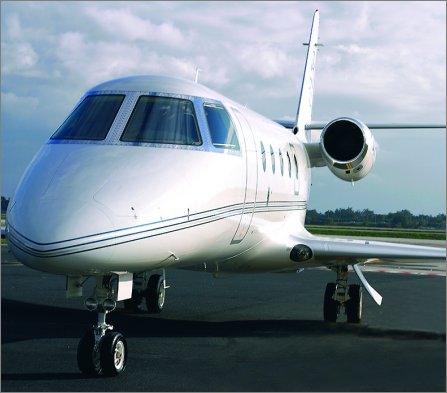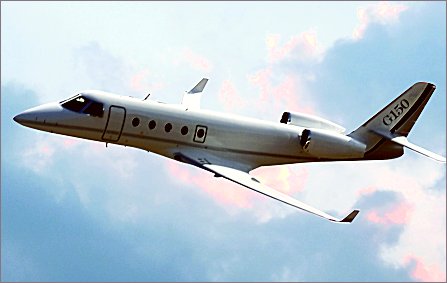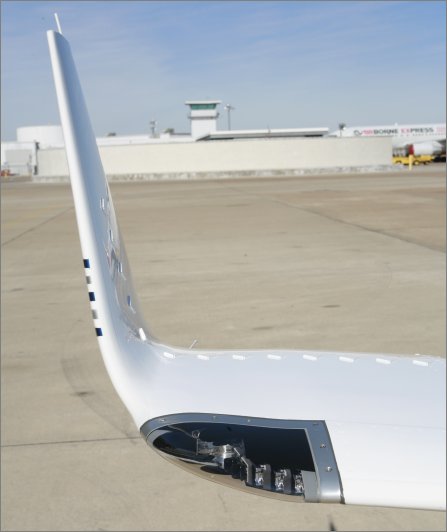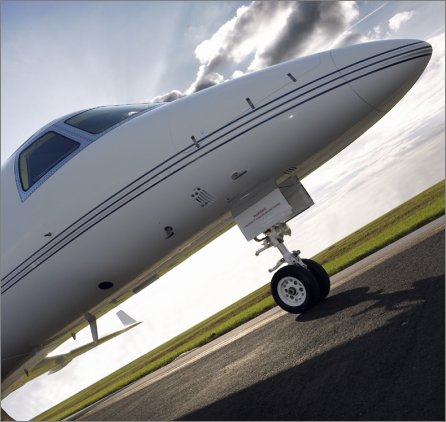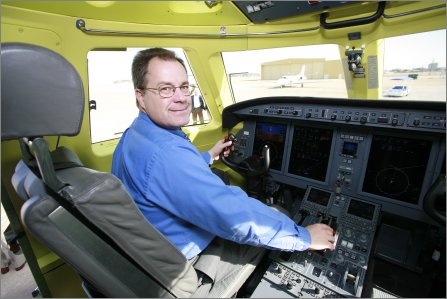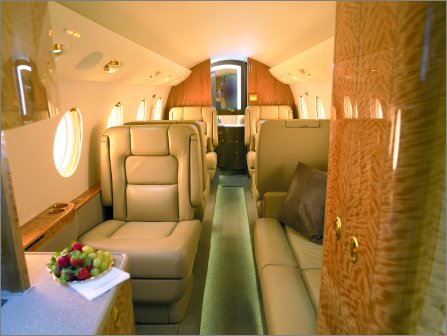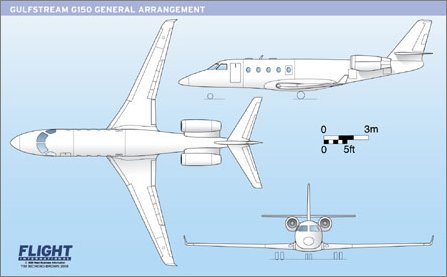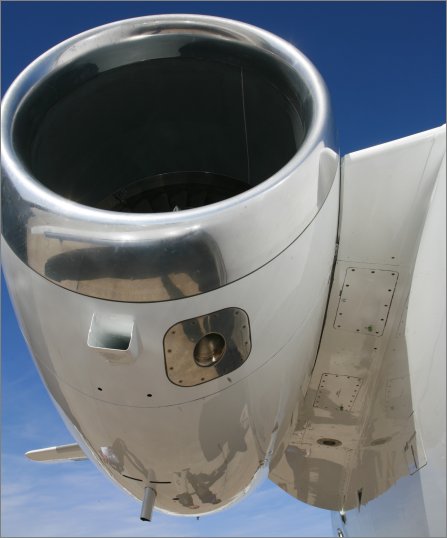A bigger cabin, new cockpit, improved systems and all the performance of its predecessor look set to make Gulfstream’s G150 business jet a mid-size winner
Gulfstream’s newest business jet, the G150, can trace its lineage to Israel Aircraft Industries’ Astra, but the aircraft is essentially an all-new entry in the increasingly competitive mid-size sector. A new cockpit, bigger cabin, improved systems and a new look set the G150 well apart from its predecessors.
|
|
| A shorter reshaped nose and longer,wider cabin give the G150 a disntinctly different appearance. |
Production of the Astra began in 1985, with the improved SP model following in 1990. A total of 68 Astras and Astra SPs, which shared the same fuselage and wing, were delivered before production ended in 1995. The Astra SPX, first produced in 1996, sported new avionics, engine and supercritical wing with winglets. In 2001, after Gulfstream’s parent General Dynamics acquired Israeli-US business-jet joint-venture Galaxy Aerospace, the SPX was rebranded the G100. While the Mach 0.87 SPX/G100 was a market success, with 77 delivered before production ended in 2004, the aircraft suffered from the perception that it was not a “real Gulfstream”.
While Gulfstream may not have developed the G100, since it took the Astra family beneath its wing the aircraft has benefited from the manufacturer’s legendary customer service. The 145-aircraft Astra/G100 fleet has amassed over 521,000h with a phenomenal dispatch reliability of 99.74%.
But the market has changed since the Astra was designed. In the past, executives were willing to tolerate cramped cabins for the benefits of high-speed point-to-point travel. The original Learjets were fast, but had small-diameter fuselages. The Hawker HS125 was the first mid-sized business jet, offering a larger cabin, but with a slower cruise speed than a Learjet.
Raytheon Aircraft’s latest rendition of the venerable HS125, the Hawker 850XPi, still offers the largest cabin cross-section in the mid-size class with an internal height of 1.75m (5.74ft) and width of 1.83m. This compares with the Bombardier Learjet 60’s 1.74m cabin height and 1.81m maximum width, while Cessna’s rival Citation Sovereign offers an interior height of 1.68m and width of 1.70m. Against this competition, the G100’s fuselage cross-section – carried over from the 1960s-vintage Westwind – at 1.70m high and 1.45m wide was becoming increasingly unattractive.
What the G100 lacked in cabin space it offered in long range and high cruise-speed for its class. In developing the G150, Gulfstream and its partner IAI aimed to capitalise on the G100’s strengths while winning the mid-size space race. Rather than increasing cabin volume just by stretching the cabin 17cm, Gulfstream also chose to insert a lateral plug. Widening the fuselage 30.5cm gave the G150 a nearly square cabin cross-section with a maximum height of 1.75m and width of 1.75m. While the 850XP’s near-circular cabin is wider, the G150’s unique cross-section offers more usable space.
Lateral stretch
Three cabin configurations are available for the G150. The six-passenger “Executive 6” has club-four seating forward and two individual seats forward of the standard aft lavatory and closet section. The “Universal 7” has a two-seat divan and individual seat forward with aft club seating. The “Hallmark 8” is nearly identical, but with a shortened galley that allows for a second individual seat forward opposite the divan. The individual leather seats and divan offer 16g dynamic impact protection. The longitudinal fuselage plug, meanwhile, allows the G150 to keep a 40.6cm wide aisle while offering 57.1cm wide seats, 12.7cm wider than the G100’s.
Gulfstream did not stop there as it forged the G100 into the almost totally new G150. Up front the aircraft has a shortened and reshaped nose section that provides larger cockpit windows. Cabin windows have also been changed to a larger vertical oval shape, much like those of the super mid-size G200 built by IAI for Gulfstream. The fuel system has been simplified by deletion of the leading-edge tanks and several valves, yet fuel capacity has been increased to 4,672kg (10,300lb).
|
|
| A shorter reshaped nose and longer,wider cabin give the G150 a disntinctly different appearance. |
As with its previous updates of the GIV and GV to produce the G450 and G550, Gulfstream left few stones unturned in an extensive drag-reduction programme for the G150. New or improved seals were installed over the aileron-wing gaps, lower inboard flap-wing, elevator-horizontal stabiliser and airbrake hinge gaps. The full-span cover plate where the leading edge attaches to the wing box was reinforced and stiffened to prevent flexing under load causing laminar flow-destroying ripples. Flow-visualising paint showed there was significant separation at the wing-winglet junction, so 13 vortex generators were placed mid-chord to keep the boundary layer attached. And, as with the G450 and G550, the APU exhaust area received detailed attention, resulting in a lower-profile heatshield. In total these drag reductions allow Gulfstream to quote an improved maximum range with four passengers and NBAA IFR reserve of 5,470km (2,950nm), 470km greater than promised at aircraft launch.
While the Astra/G100 already has an impressive dispatch reliability record, Gulfstream used an extensive review process to reduce maintenance and further enhance reliability. Using MSG-3 guidelines, major maintenance intervals have been increased two-fold to 500h. Based on operational experience, the top 20 removal items for the Astra/G100 were either improved or replaced. A number of the improved systems, such as the nosegear steering control, were taken from the G200. Gulfstream has confidence in the improvements: a five-year warranty is standard for the entire aircraft with various components guaranteed from 2,000-5,000h. Direct operating costs, exclusive of fuel, are projected at $580/h.
Flight International was invited to fly a G150 at Gulfstream’s Dallas Love Field completion centre. Like the G200, the G150 is assembled by IAI in Tel Aviv, Israel and flown “green” to Love Field, where Gulfstream fabricates and installs the cabin interior. Since the company took over the G200 (formerly IAI Galaxy) in 2001, completion cycle times have been reduced from over 40 weeks to approximately 11 weeks, and Gulfstream anticipates a completion cycle time of 11 weeks for the G150. The test bird for our flight was a production-representative development aircraft lacking a cabin interior. Senior production test pilot James Allen accompanied me on the flight and made the walk-around inspection. All access panels were easy to reach, but a small step ladder is needed to check engine oil level on the first flight of the day.
The pneumatic de-ice boots on the wing and horizontal-stabiliser leading edges are unusual for an aircraft with a M0.8-plus cruise speed. Most aircraft in this class use bleed air to anti-ice the wing and sport a polished leading edge. The G150’s leading edges are silver; only on close inspection does one realise they are pneumatic boots.
The heated external baggage compartment is accessible from ramp level, providing 1.56m3 (55ft3) of space. Cabin entry is facilitated by four integral steps in the partial plug door. The door has two seals, one static and one pneumatic and, should the pneumatic seal fail, the aircraft is dispatchable but restricted to FL410, only 4,000ft below the service ceiling of FL450.
Full horizon
The cockpit features a four-screen Rockwell Collins Pro Line 21 integrated avionics system. The 30.5cm x 25.4cm liquid-crystal displays are arranged two per side in portrait format. The outboard screens typically serve as each pilot’s primary flight display (PFD). Transparent-tape airspeed and altimeter read-outs on the attitude director indicator (ADI) portion of the PFD allow a full-span (24.1cm) horizon line to be displayed.
Safety is further enhanced by the way traffic collision avoidance system (TCAS) cues are displayed. In many aircraft, traffic alerts (TA) and resolution advisories (RA) are displayed on the vertical velocity indicator, forcing the pilot to reference this instrument as aircraft pitch attitude is adjusted to provide safe separation. On the G150 ADI, a yellow fly-to box and red threat box are presented on the ADI in response to a TA/RA, significantly easing the task of avoiding the conflicting aircraft.
|
|
| Vortex generators (above) reduce drag |
One area where Gulfstream has led the industry is in the development of its Planeview integrated flightdeck. Standard in the company’s large-cabin business jets, the Planeview cockpit features sidewall-mounted cursor control devices (CCD) and large-format displays. While not installed on the test aircraft, production G150s will have Gulfstream’s signature CCD and provide Planeview-like functionality. During previous flights in the G450 and G550 I found the CCD and Planeview to be intuitive to operate, offering ready access to many avionics functions.
Single or dual Collins integrated flight information systems (IFIS) are optional on the G150. The single IFIS allows real-time aircraft position display on geo-referenced electronic Jeppesen charts, a significant safety-enhancing feature. Dual IFIS gives the aircraft a paperless cockpit capability.
APU electrical power was used for engine start, each engine reaching idle RPM in less than 30s. Peak inter-turbine temperature during the digitally-controlled start for both engines was 760°C (1,400°F), well below the start limit of 990°C. Once both engine-mounted generators were brought on line, the APU was shut down. A slight bump of the thrust levers started the aircraft rolling on the level ramp.
Once rolling, idle thrust was sufficient to maintain taxi pace. I found the G150’s nosewheel steering (NWS) easy to control via the sidewall-mounted tiller. Unlike the G100, limited NWS control (±3°) is also available through the rudder pedals. Using pedals alone I was able to track taxiway centrelines easily, with the tiller required to negotiate the 90° turns en route to Love Field’s runway 31R. Flaps were set to 20° for take-off, the full-span leading-edge slats deploying to the down position.
Once aligned with the runway centreline I advanced the power to mid-range and released the toe brakes. Once rolling I jammed the throttles to the forward stop, the digital electronic engine controls (DEEC) smoothly setting a take-off N1 (fan speed) of 92%. With 3,166kg of fuel, the 9,744kg aircraft accelerated to a rotation speed of 123kt (228km/h) indicated, lifting off approximately 30s after brake release with a ground roll of 1,100m.
At the aircraft’s 11,840kg maximum weight, Gulfstream lists a take-off distance of 1,524m – slightly shorter than the Learjet 60’s 1,661m, but much longer than the Sovereign’s 1,091m. Given that the G150 has a slatted leading-edge, these numbers are, at first, somewhat puzzling. An examination of respective thrust-to-weight ratios is instructive, as take-off distance is a function of excess thrust and lift-off speed. Although not in identical conditions, my flights in the Sovereign and G150 were with approximately half maximum fuel-load. Rotation speed for the Cessna with its bigger and less swept wing was 103kt, markedly lower than the G150’s 123kt. But the penalty of the Sovereign’s lower sweep is a slower cruise speed – M0.8 to the G150’s M0.85.
Yoke forces
One complaint relayed by a number of Astra/G100 pilots to Gulfstream was that yoke forces at rotation were too high. For the G150, the elevator control-tab deflection ratio went from linear in the G100 to one that increases tab deflection as the elevator is deflected. Control yoke forces to rotate the G150 to its 14° nose-high take-off attitude were about 27kg, less than the 34kg maximum allowed by US certification standards. Once airborne, longitudinal yoke force changes were minimal as the landing gear, flaps and slats were retracted.
|
|
| A shorter reshaped nose and longer,wider cabin give the G150 a disntinctly different appearance. |
The thrust levers were retarded to the cruise flat-spot and the G150 allowed to accelerate at FL400. After several minutes the 9,390kg aircraft stabilised at 244kt and M0.82. With a static air temperature of -56°C, the G150 had a total fuel flow of 717kg/h (1580lb/h) and a true airspeed of 466kt. With four passengers and standard-day conditions, Gulfstream lists a normal cruise speed of M0.8 and a range of 4,818km. Slowing the G150 to the long-range cruise speed of M0.75 at test-day conditions gave a true airspeed of 427kt with a total fuel flow of 508kg/h. Gulfstream publishes a range of 5,470km with four passengers at long-range cruise.
|
|
| Pilot Mike Gerzanics settles into the new cockpit |
The G150’s range gives it an impressive operational capability. Assuming 85% annual winds and NBAA IFR reserves, the aircraft can take four passengers from Los Angeles to Honolulu or Gander, making Europe one stop from the US West Coast. At M0.80 the G150 has transcontinental reach – New York to Los Angeles or Seattle nonstop. Compared to its mid-sized rivals, Gulfstream says, this provides significant time savings on a notional sortie from New York (Teterboro) to Los Angeles (Santa Monica). Four passengers in a G150 will arrive in LA in 5h 44min - 22min sooner than in the more expensive Sovereign and 53min before the Hawker 800XPi.
Slight buffet
While still at FL400, at 236kt/M0.79, I executed a series of 45° angle-of-bank steep turns. Roll and pitch forces were heavy, but well harmonised as the nose tracked smoothly across the horizon. Only a slight airframe buffet alerted the pilot during manoeuvres at this somewhat extreme condition.
|
|
| Cockpit has more usable space than seats (above) |
To simulate an emergency descent, I rapidly retarded the thrust levers to idle and fully deployed the airbrakes using the centre-console switch. With two airbrake panels up per wing, a M0.84 descent was established. Pushing the nose over accelerated the G150 and an audible ditter (altimeter) and red band on the airspeed tape alerted me that we were at M0.85, the maximum operating Mach (Mmo). There was no tendency for the aircraft to tuck under at Mmo and its response to sharp control inputs in all three axes was well-damped. I levelled the aircraft at 15,000ft and 330kt (VMO) 2min 57s after starting the descent, an average of nearly 8,500ft/min.
With 2,640kg of fuel, two stalls were performed to assess the G150’s low-speed qualities. In a clean configuration and idle power the aircraft was slowed at a rate of 1kt/s. At 138kt and 0.8 units angle-of-attack (A0A), a slight airframe buzz was felt as the leading-edge slats automatically deployed. At 120kt, light airframe buffet and an audible stall warning indicated we had reached the certificated stall speed. Pulling the yoke full aft slowed the aircraft to 110kt, establishing a fully developed stall. The aircraft settled into a stable nose-high attitude, with small rudder deflections needed to keep the wings level. Stall recovery was effected by relaxing yoke back-pressure and advancing the thrust levers. The high fuselage-mounted engines aided in pitching the nose down, facilitating the recovery to normal flight conditions.
Docile performer
The second stall was performed in a landing configuration, geardown and flaps full (40°). As with the clean stall, airframe buffet preceded the audible stall warning at 112kt. Recovery this time was effected by advancing the power and maintaining level flight. At 130kt I retarded the thrust levers and performed a series of 45°-banked turns, the G150 showing itself to be a well-mannered and docile performer.
|
|
At 1,000ft above ground level I disengaged the autopilot for the last portion of the approach. At 50ft I retarded the thrust levers to idle and initiated the flare manoeuvre approaching 10ft. Touchdown was in a nearly level attitude for the 40° flap configuration. On touchdown all four airbrake panels on each wing automatically deployed to dump lift. Moderate reverse thrust and wheel braking smoothly slowed the G150 to taxi speed for runway turn-off. Gulfstream’s published landing distance of 878m, longer than the Sovereign’s but shorter than the Learjet 60’s, seems attainable for a proficient pilot.
The flaps were set to 20° while taxiing back to runway 34R for take-off. Thrust setting was again 92% N1, with VR of 122kt and V2 of 139kt. Once airborne with the gear retracted, Allen pulled the right thrust lever to idle to simulate a power loss on departure. At 150kt, less than 40kg of rudder force was required to maintain wings-level coordinated flight. During the climbout I found the available rudder trim sufficient to reduce pedal forces to zero with take-off power still set.
|
|
| Engine Pylon re-design has reduced interference drag |
A visual approach to Dallas Love Field’s runway 31R was flown with the flaps set to 20° at a VREF of 134kt. N1 on the left engine was approximately 74% and less than 5kg of pedal pressure was required on final approach with rudder trim set to 200. Power was again retarded to idle passing 50ft, with touchdown in a slightly higher nose-up attitude than when landing with 40° of flaps.
On touchdown the airbrakes automatically deployed, reverse thrust on the left engine and wheel brakes slowing the aircraft to taxi speed. During the landing rollout pedal-actuated nosewheel steering allowed me to track runway centreline accurately. Taxi back to Gulfstream’s ramp was uneventful, with shutdown and post-flight flows easily accomplished.
Before acquiring and rebranding the Astra and Galaxy, every new Gulfstream aircraft went further and carried more people than the one it replaced. The G150 represents the company’s re-entry into the mid-size market segment. The lateral fuselage stretch gives the aircraft a cabin with class-leading usable space while the four-display Pro Line 21 avionics suite with sidewall CCDs provides Planeview-like functionality at a fraction of the cost of a G450 or G550. And the G150 offers true trans-continental range at M0.80 speeds. While it may be based on the Astra, the G150 has evolved into a full-fledged Gulfstream.
MIKE GERZANICS / DALLAS
Source: Flight International





















